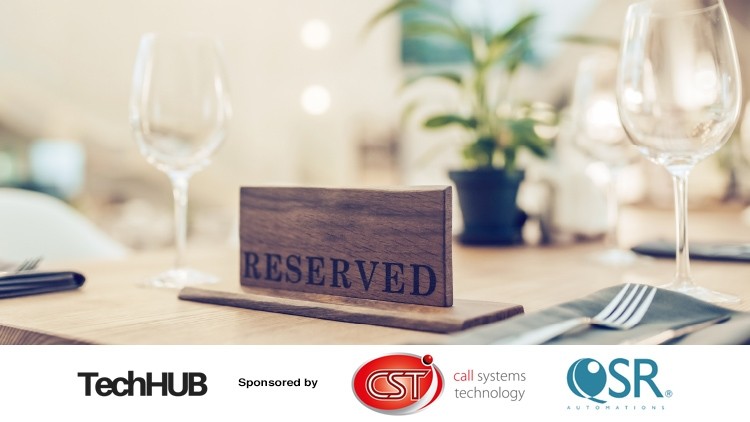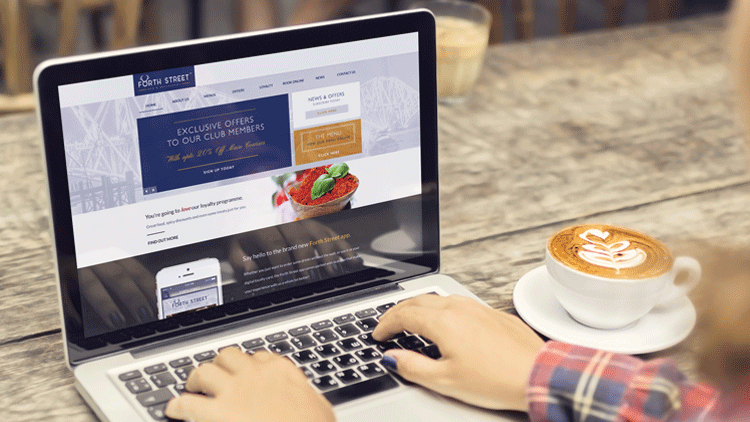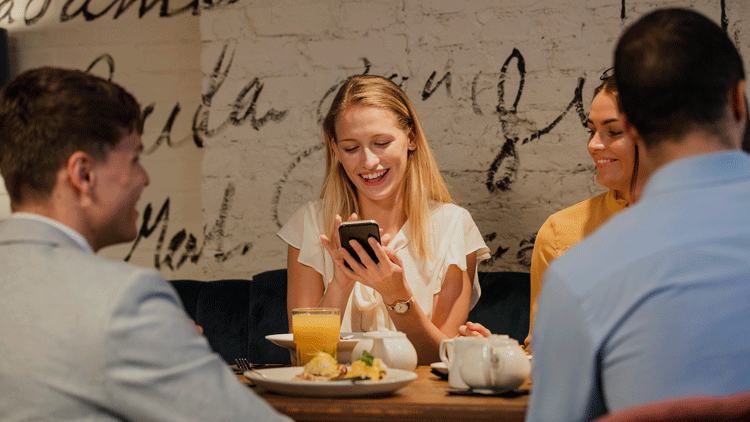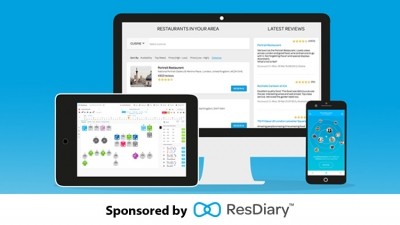Seating Plans: How reservation tech can put restaurants ahead of their competitors

Almost everyone does everything online these days- from shopping to banking to booking a holiday, so it's no wonder that most consumers want to make restaurant bookings on the internet too.
And with a smartphone in their pocket and a plethora of booking apps available, it’s never been easier for a diner to find a restaurant and make a booking while on the move: unsurprisingly, according to a GO Technology report, 60% of consumers booking a restaurant online do so on a smartphone. With this is mind, restaurant operators would be wise to embrace online reservations technology.
No shows, no more
It could be argued that the casual ease of reserving a restaurant online, without even having to pick up the phone and speak to someone, can lead to an increase in consumers not turning up for their booking. But online reservations technology does have some tricks up its sleeve to tackle the issue.
“While online booking apps are answering consumers’ demand for a more streamlined service, they can cause an additional headache for restaurants who have seen a sharp rise in no-shows over the past few years – sometimes by as much as 20% to 30%,” says Shaun Puckrin, chief product and innovation officer at Worldpay.
“It’s important that operators see technology as the friend, not the foe – solutions like Worldpay Total Hospitality can enable restaurants to tokenise a debit or credit card on booking, which can help protect against no-shows or walk outs.”
“We’re hearing all too often about the increasing plague that is no-shows. This is a huge revenue drain for the industry and being partly blamed on the ease with which customers can make online reservations,” says Lee Leet, CEO at QSR Automations.
“However, operators can manage the crisis with some digital know-how. By choosing an online reservation system that provides in-built customer communication capabilities, operators can open up more ways to keep in touch with customers.”
David Charlton, sales director at Zonal, says a technology-based online booking system – such as the company’s liveRES – is a vital tool in combating no-shows.
“With liveRES, operators can send automated reminders to guests prior to their visit via email and SMS, and guests can confirm if they are still coming by a touch of a button. If they cancel, this will automatically feed through to the diary and release the table immediately on the website and other integrated booking channels.”
Reservations system Bookatable by Michelin has an automated reminder function that director of central account management Andrea Haldane says is effective at reducing no-shows.
“Since this release [of automated booking reminders] the no-show rate went from 3% to less than 2.5% and has helped increase covers by 10%. Having a brief reminder email sent to the diner increases the relationship between the diner and the restaurant, so that they are more likely to show up.”
ResDiary also has an automated reminder function on its system and uses various forms of payment protection, from full payment and deposits, to storing card details to charge the card in the event of a no-show.
“There has been lots of information in the news about operators starting campaigns against no-shows, naming and shaming guests, and writing blogs about the issue,” says chief executive officer Mike Conyers.
“While all of these might raise awareness, they don’t put lost money back in the restaurateur’s pocket, and that’s why we believe operators need tech that will do that for them.”
Turning quiet times busy
Wouldn’t it be great if you could easily – and instantly – promote a special offer to drive business to your restaurant at quiet times? Well, with online reservations technology you can – and the scope for promoting discounts in off-peak periods is expanding.
“The temptation for many venues is to turn to a deal site and promote a cut-price menu through that channel at off-peak times. However, as food prices, rates and staffing costs rise, many operators find the commissions on top of money-off makes this financially non-viable, says ResDiary’s Conyers.
The company has created a feature called ResDiary Off-Peak, which allows restaurants to set different prices for different times, upping their costs when it’s busy and boosting bookings with lower prices at traditionally quiet times. They can then promote off-peak deals through ResDiary.com, social media, and their websites at no extra cost, according to the company.
“The next step for us is to take this variable pricing functionality and make it dynamic, automatically raising prices at busy times,
and lowering them when bookings are slow,” adds Conyers.
Online bookings are in invaluable way of understanding customer behaviour
LiveRES also has a platform that it says provides operators with all the data they need to identify quiet periods when a special offer might be beneficial.
“The trick to driving business at off-peak times is smart availability and offer management. All bookings have a date and time against them so restaurants can review customer behaviour and trends,” says Charlton.
“This helps build a picture of how far in advance bookings tend to be made, putting operators in a better position to foresee busy and quiet periods and manipulate the availability settings in their reservation system to push guests to shoulder periods. Ultimately, we want to create the airline approach, where prices have the ability to change depending on demand.”
Being smartphone smart
In the past 12 months, 58% of reservations made through ResDiary.com were processed on a mobile, according to the company, with 12% made on a tablet. What’s more, 64% of mobile restaurant searches convert to bookings within an hour, meaning diners are looking for quick and easy ways to book on their mobile.
“Because of this, every consumer-facing ResDiary feature is designed to work as well on a smartphone as on a desktop, from finding tables, to making the reservation, and even placing a pre-order,” says the company’s Conyers.
“Smartphone usage will only continue to grow and it’s important restaurants recognise this. User journeys are different on desktop to mobile, and venues need to ensure they are optimising their bookings for smartphone users.”
Matt Simpkin, vice-president for western Europe at Quandoo, says that ‘restaurants near me’ remains one of the most widely used search terms on the internet, so giving diners the ability to book on their smartphone is vital.
“A big thing for smartphones that has been growing during 2018 is the use of Applemaps and Googlemaps to book a restaurant directly. Quandoo is integrated into these map apps, which means customers can locate restaurants around them using this function, find available times and book with three taps of the phone – no need to even go via a reservation portal or a customers booking tool,” he adds.
Smartphone's can help ease diner congestion at busy times
Harnessing smartphone technology can also help ease diner congestion as busy times. QSR DineTime Host, for example, is a restaurant guest app that allows diners to book reservations directly from their smartphones. Each booking syncs with the DineTime Host solution and populates a restaurant’s waiting list, keeping the host stand organised.
“A good online reservation app will be part of a platform that encompasses waitlist management, the guest book and operational analytics to feed marketing,” says QSR’s Leet.
“Digital booking channels can give customers the option to add guests to a booking themselves, bringing more business through the door with no further input from the operator.
“These platforms also gather vital consumer data, allowing operators to personalise the experience to the individual to promote events, new dishes and special offers. This opens the door to either increasing party spend or encouraging customers to come in when they otherwise might not have.”
Ticketing uplift
When ResDiary launched its ticketing system almost 10 years ago, it was pretty much unheard of for restaurants to sell tickets or use any form of advance payments. However, the uptake of ticketing technology in the restaurant sector has rocketed in recent times.
“Recently, we’ve had hundreds of restaurants start to use it,” according to Conyers, who adds that the company now supplies a large range of hybrid venues, such as bar-restaurants, pub-restaurants and bar-clubs.
“Each business has different needs. We’ve had people use ticketing for wine dinners, live music events and even apply ticketing to all reservations to stop no-shows.”
In ResDiary, venues set up their event, or the conditions in which they want full ticketed payment, from within their diary. They link this to their Stripe payment account and it is automatically shown on their booking widget, according to their rules. The customer’s customised confirmation email acts as a ticket, and the revenue is in the business’s account within seven days.
Paying and ordering online
A customer may have found and booked a restaurant using their smartphone, but the online aspect of their dining-out experience doesn’t necessarily end there. These days, it’s increasingly becoming the norm to order and pay for a meal online too.
According to research by Worldpay, 67% of 16 to 20-year-olds are interested in placing their order online before travelling to a restaurant or bar. What’s more, in under two years, the number of consumers who use mobile devices for payment has risen from 2.4 million to 3.1 million (source: GO Technology).
“For operators, online ordering and payment is a worthwhile investment, as 82% of the 5,000 adults surveyed for GO Technology are more likely to use a venue’s own app as opposed to a third-party provider,” says Zonal’s Charlton.
“And it’s a very effective tool in terms of driving additional orders from each customer, with 67% of 25 to 34-year-olds saying they would spend more if they could order from their smartphones rather than queue at the bar or wait for table service.”
Restaurant operators are certainly sitting up and taking notice of the trend, with Zonal seeing a 400% increase in enquiries over the past year from high-street hospitality operators wanting to develop their own branded app using Zonal’s white label Order and Pay app. With the app, customers can make a booking or order and pay for food and drink while on their way to, or at, the venue.
Quandoo is an advocate of linking EPoS with table management system and pay at table functionality
Quandoo is also seeing an increase in hospitality operators looking for an order-and-pay app, especially one that can create a seamless experience for diners.
“Many companies are using pay-at-table plug-ins where you still have to ask the waiter for your table number to make the payment, which remains a clunky solution,” says Quandoo’s Simpkin.
“However, linking your EPoS with your table management system and your pay at table functionality provides the biggest wins to the customer experience but also to your management reporting.”
At Quandoo client Côte, diners are checked in on the Quandoo table management system, which automatically opens a tab on the Comtrex till system. This EPoS integration also enables the customer to pay at the table without needing to ask for their table number, as the Quandoo app is fed back with the table number and bill.
Simpkin adds: “This is a game-changer for the diner experience and is providing invaluable data, allowing restaurants to link their table management data with their spend data.”






















